Project anti-ship missiles KSS
In 1953, the airborne KS-1 “Comet” cruise missile, which was proposed for the destruction of various types of surface targets, was adopted for service. This product had sufficiently high characteristics that could make it a reliable and effective weapon, and not only for marine aviation. Soon after the adoption of the Comet system, the study of the prospects of the KS-1 product as a base for arming other platforms began. First of all, the possibility of installing the "Comet" on ships and special coastal launchers was considered. In the future, this led to the emergence of several interesting projects. Some of them went into operation, while others could not be removed from the test stage.
Work on new weapons based on the KS-1 was launched in accordance with the decision of the Council of Ministers, released in April 1954. The country's leadership demanded the development of anti-ship missile systems of sea and coast-based. They received the symbols KSS and "Arrow". The design was entrusted to two organizations that already had experience in creating guided weapons: KB-1 and OKB-155. The latter, it should be noted, performed most of the work on the Comet project, and therefore he was entrusted with the further development of this rocket. In the future, this allowed us to speed up the work and get the expected results in the shortest possible time.
According to the plans of the early fifties, in the near future the navy was to receive several light cruisers of the 67 project, equipped with a new type of anti-ship missile system. The basis of the promising missile system was to be the KSS rocket (“Comet - Projectile Aircraft”). To control the rocket, it was proposed to use the ship’s regular radio electronic systems and the new Quiver equipment. This project did not lead to any significant results, but is of great interest. In addition, he allowed to study some features of the use of missiles, which further helped with the creation of new weapons.
The KCC complex should consist of several basic elements. They were a guided cruise missile, a launcher for it, and a set of electronic equipment designed to control shooting, interact with other ship systems, etc. According to reports, all the electronics of the complex was built on the basis of the existing components and assemblies. The launcher had to be developed from scratch, and the KSS rocket was proposed to be made on the basis of the existing KS-1 product.
The development of the Kometa - Projectile rocket was one of the simplest stages of the new project. The base rocket KS-1 has already managed to pass all the tests and entered into service with naval aviation. Thus, the available units no longer required verification. At the same time, however, it was required to provide a new way to take off. The airborne “comet” was dropped from a carrier aircraft at a certain height with a certain initial speed, and the new KSS would have to accelerate and gain altitude independently or with the help of some additional aggregates: a launcher, a starting engine, etc. Thus, a solution to the startup problem was required.
This issue was resolved fairly quickly. To start the KCC proposed to use the rail starting guide and the starting solid-fuel accelerator. In the tail section of the rocket, mounts for a propulsion engine of the type SPRD-15 appeared, up to 40 tons, sufficient for the initial acceleration of the rocket. In addition, the means of attaching the rocket to the launcher were changed: the base CS-1 was suspended under the wing of the carrier, and the sea CSS should start from a beam system installed with the required angle of elevation.
The rest of the guided missile remained the same. Like the KS-1, it received a streamlined, elongated fuselage with a frontal air intake, resembling units of the MiG-15 fighter. The total length of the rocket reached 8,5 m. It was equipped with an arrow-shaped wing with a span of 4,7 m, as well as an arrow-shaped keel with an intermediate stabilizer. To reduce the size of the rocket in the transport position, the wing received hinges for folding by turning it upwards. In the rear fuselage also provided for mounting for additional vertical tail. The starting weight of the product was 3419 kg, including 479 kg of powder accelerator.
The rocket retained the main engine of the prototype. In this capacity, a turbojet RD-500K engine was used, up to 1500 kg. The fuel system had several tanks with a total capacity of 320 l. A similar supply of fuel allowed the rocket to fly a distance of 100 km. At the same time, the real range of the use of weapons depended on other parameters, primarily on the characteristics of radar stations for detection and guidance. Such means of that time did not differ in high performance, because of which the launch of the KSS over long distances was not possible.
KCC has used a proven and proven guidance system. In the first part of the trajectory, the rocket was supposed to move, taking the signal from the radar guidance and adjusting its position in space. At the same time, the receiver and the barometric altimeter worked. This mode of operation of the equipment was designated by the letter "A". Mode "B" was activated at a distance of several tens of kilometers from the target. Turning to the second mode, the equipment should have captured the target using its own radar homing head. In this case, the carrier highlighted the target, and the GOS received the reflected signal and it should have guided a rocket.
Inside the fuselage of the rocket, a high-explosive warhead weighing 860 kg was placed, sufficient to defeat various ships and conventional enemy ships. The warhead was equipped with a contact fuse, with which it was provided undermining when touching the target.
To use the new rocket on advanced warships, the CM-58 turret launcher was developed. She had two guides for missiles of length 12 m and could be induced in azimuth. The elevation angle of the guides was determined in advance and did not change - 10 °. The main tower of the installation had a reservation able to protect the crew and the missiles from some attacks. The installation could be completed with two versions of the cellars for the ammunition with missile systems for launching the launcher. Thus, the nasal ship launcher could receive 11 ammunition of missiles, aft - up to eight.
The calculated method of using the KSS missiles of the prospective anti-ship complex looked as follows. With the help of standard detection means the carrier ship was supposed to monitor the surrounding space. Having found the target, he had to take it on accompaniment and begin preparations for the launch of the missiles. From the corresponding cellar on the rail launcher should submit a rocket. After that, the installation was directed towards the target and launched. By the time of launch, the KSS turbojet engine was supposed to work on take-off mode, however, it was proposed to descend from the guide due to thrust from the solid-fuel accelerator.
The objective of the product SPRD-15 was the rise and initial acceleration of the rocket. After the charge burned, the starting engine was suggested to be shot off. Next, the rocket had to fly to the target independently using a turbojet engine, using different modes of operation of the equipment. After the launch of the rocket, the task of the carrier ship was to accompany the target and to highlight it with the help of the corresponding radar. In the automatic mode, the KSS rocket had to go out to the guidance signal and then work in the “A” mode. At the same time, the flight altitude was of the order of 400 m, the speed was about 1050 km / h, and the direction to the target was kept.
At a distance of the order of 15-20 km from the target, the power of the backlight radar signal reflected by it allowed the rocket's GOS to capture. Further, the work was carried out in the “B” mode with a pointing at the source of the reflected signal until the rocket hit it. The KSS missile, weighing about 2,5-2,8 t, flying at speeds in excess of 1000 km / h, should have caused serious damage to the target, even at the expense of its energy. In addition, the destruction was intensified by undermining the 860-kg warhead. Thus, one KSS missile could inflict significant damage on any ship, even a relatively large one, and the successful hit of several could lead to its guaranteed death.
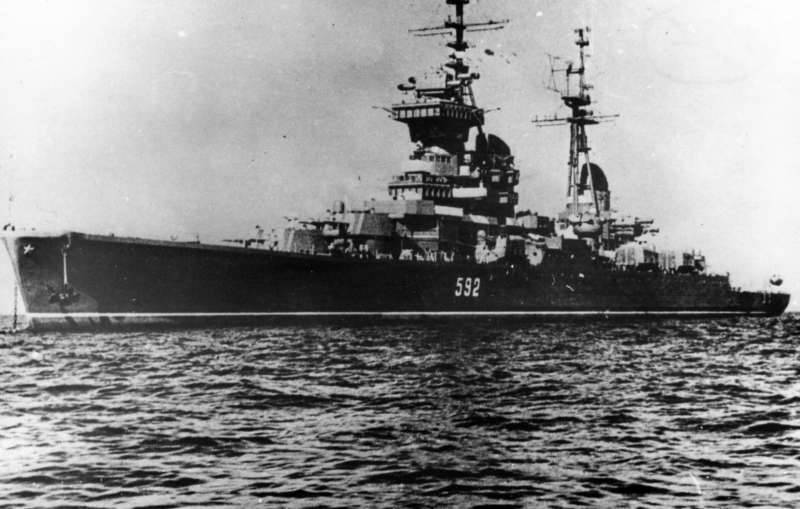
The cruiser "Admiral Nakhimov" in 1958, after the completion of the tests. Nose tower unlocked launcher filmed. Photo Tsushima.ru/forums
Thanks to the use of a ready-tested tested rocket, the project of an anti-ship complex with an KSS missile was developed in a relatively short time. Already in the year 1955 was ready a full package of technical documentation, which should be used in the preparation of carrier ships. In the same year, an order was issued to re-equip one of the existing ships into the carrier of promising missiles.
As the first carrier of cruise missiles, which was to participate in the trials, the light cruiser “Admiral Nakhimov” of the 68-bis project was chosen. This ship was laid in 1950, launched in 51, and in March 53 became part of the Black Sea Fleet. In 1955, it was decided to re-equip this cruiser with the new 67-EP project, which included the installation of launch equipment and new electronics for the use of KSS missiles. To simplify the rework, the 67-EP project implied the use of new units of relatively simple design.
Due to the experimental nature of the rework, the cruiser “Admiral Nakhimov” has undergone unusual changes. His nose tower was deployed at 90 ° and welded to barbet in this position. Guns blocked at elevation angle 45 °. Directly in front of the tower on the bow of the ship secured the launcher for the KSS rocket. In the middle part of the superstructure, two hangars were placed on two missiles each. Between the hangars and the launcher, paved rail tracks for transport trucks, with the help of which it was proposed to deliver missiles to the ship’s nose.

Side view of the cruiser "Admiral Nakhimov" in the version "67-SI" with a bow launcher CM-58. Figure Bastion-karpenko.ru
The following ships of the 67 project were planned not to be re-equipped from existing cruisers, but to be built from scratch. The main difference between these ships and the 68-bis cruisers was the presence of two CM-58 launchers in front of and behind the superstructure. In 1959, the lead cruiser of the new type, the Admiral Kornilov, was to enter service. On 61, the fourth ship was scheduled for delivery. By the beginning of the construction of new cruisers, it was planned to complete all the tests with the participation of "Admiral Nakhimov."
The first launch of the KSS missile from the Admiral Nakhimov spacecraft took place on January 22, 1956. Later, several more shootings were conducted, during which the behavior of the missiles in the early stages of flight and other features of the promising complex were studied. In early June, launched the second phase of testing, during which the cruiser launched missiles on a conditional target. In order to avoid its destruction, the KSS carried an inert warhead.
Before the start of winter, 17 conducted test launches on a shield target, most of which ended in success. The achievement of positive results was facilitated by the use of ready-made components and assemblies: the authors of the project needed to bring only a few systems, while others had already passed all the checks and met the requirements.
2 December 1956 of the Year "Admiral Nakhimov" started the next shooting. This time seven missiles with a high-explosive warhead were used. The decommissioned cruiser "Stalingrad" of the 82 project was used as a target. The last start of this stage was held on December 22.
The testing of KSS missiles as part of the Quiver complex on the Admiral Nakhimov cruiser took 11 months. During this time, the 24 rocket was used. 20 start-ups were recognized successful, thanks in part to the defeat of the training goal. Such results opened the way for the KCC to a great future and fleet operation.
In 1957, it was intended to send a missile cruiser to the next modernization. Now he was asked to remove the nose towers with underdeck units, instead of which an experienced CM-58 launcher should be mounted, along with missile storage and supply systems. A similar project to re-equip the light cruiser received the designation 67-SI - "Joint tests". As is clear from the name of the project, in the very near future it was planned to begin a new phase of inspections, as a result of which the missile system could be recommended for adoption.
However, all these plans were never implemented. In the mid-fifties, the armed forces of the Soviet Union were engaged in conducting major reforms, implying the reorganization of various structures, the rejection of some weapons and the development of others. Among others, some projects of promising systems for the Navy came under reduction. One of them turned out to be the 67 missile cruiser project.
Due to numerous disputes in the highest circles, the implementation of the KCC project and the construction of new type of ships were in doubt. Some representatives of the military and political leadership believed that ships like the "Admiral Nakhimov" no longer have real prospects and should be decommissioned, and the construction of new similar cruisers is inappropriate. In addition, there was an insufficiently high potential of KSS missiles when working on surface targets with a displacement of more than 15-18 thousand tons. Thus, clouds were constantly gathering over the new project.
As a result of disputes and discussions among the commanders, by the end of 1956, the production of working drawings for the 67-SI project had virtually ceased. This, in particular, did not allow to proceed to the next modernization of the carrier ship of the missiles and blocked the continuation of work on the KSS project. Over the next few months, the prospects for the new missile complex were vague and repeatedly became the subject of controversy.
Point in stories The KCC project was delivered in July 1957. The result of the next meeting of the Council of Ministers was a resolution that stopped all current work on prospective cruisers with guided missile weapons. The development of the 67 project and the construction of such ships were finally canceled, and the KSS cruise missile project was halted. Further work in the future direction should be continued in the framework of other projects.
All materials on the rocket KSS went to the archive, but the developments were not in vain. A few years before the closure of this project, along with the KSS project, the coast-based Strela system was developed. It was also proposed to equip it with a guided cruise missile based on an aviation KS-1. Thus, some of the main developments on the KSS were implemented in parallel in the Strela and found application, as well as reached mass production and operation in the troops.
The cruiser "Admiral Nakhimov" suffered a different fate. After the completion of the new project, the ship returned some of the available capabilities, which allowed him to return to the service. However, in the middle of 1960, he was expelled from the Navy, after which the ship waited for recycling.
Ironically, the only carrier of the new type of anti-ship missiles in the 1961 year was the target for the same weapon, but created in the course of another project. In June, the 61-th cruiser “Admiral Nakhimov” was taken to one of the ranges of the Black Sea Fleet, where it was attacked by the Strela missile complex П-1, installed on the destroyer “Prosperous” of the 56-M project. The P-1 / KSSh missile hit the target with serious damage, due to which it almost sank. However, the cruiser was rescued and returned to base. Soon he was transferred to the break.
Due to the changing views of the command, the KSS cruise anti-ship missile, designed to arm surface ships, has not left the test stage. Thus, the KCC project turned out to be the most unlucky representative of the family of weapons created on the basis of the Kometa KS-1 aviation missile. In parallel with it, the Strela stationary coastal missile system was developed, and later the Sopka mobile coastal system appeared. Both of these complexes included missiles created on the basis of the aviation “Kometa” and for some time were in service, ensuring the protection of the maritime frontiers of the country.
The decision to discontinue 67 family projects had some impact on the further development of domestic warships with guided missile weapons. However, the development of this direction has not stopped. The result of further work was the emergence of a large number of anti-ship missiles for ships, aircraft and coastal complexes.
Based on:
http://rbase.new-factoria.ru/
http://bratishka.ru/
http://bastion-karpenko.ru/
http://armoredgun.org/
Shirokorad A.B. Weapons of the domestic fleet. 1945-2000. - Minsk: “Harvest”, 2001
Shirokorad A.B. The history of aviation weapons. Short essay. - Minsk: “Harvest”, 1999
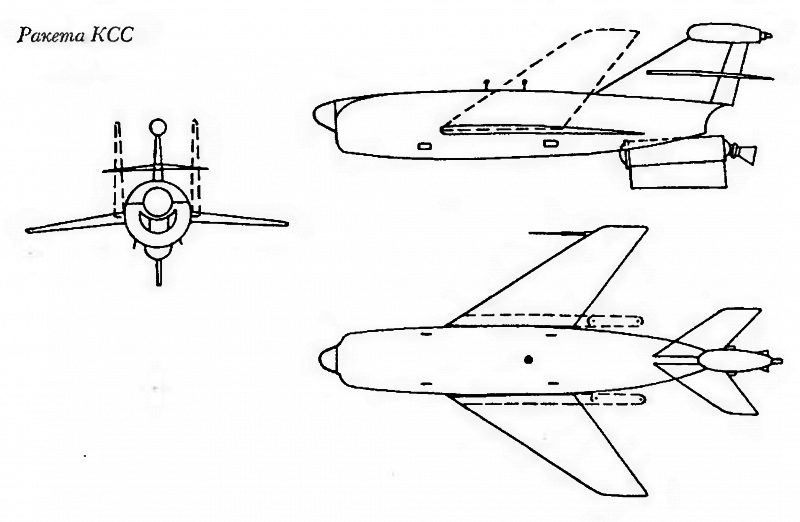
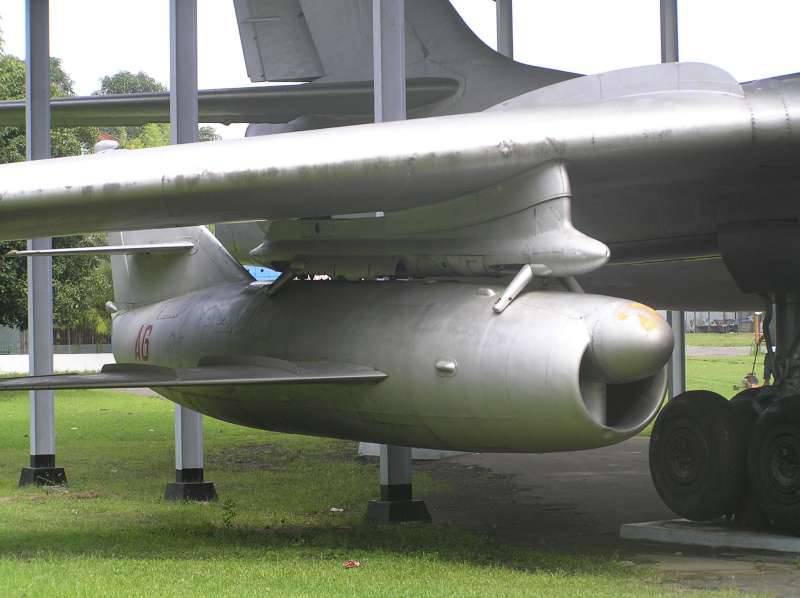
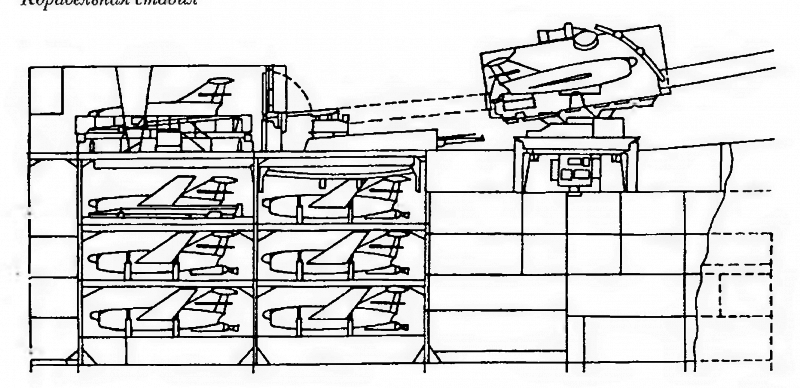

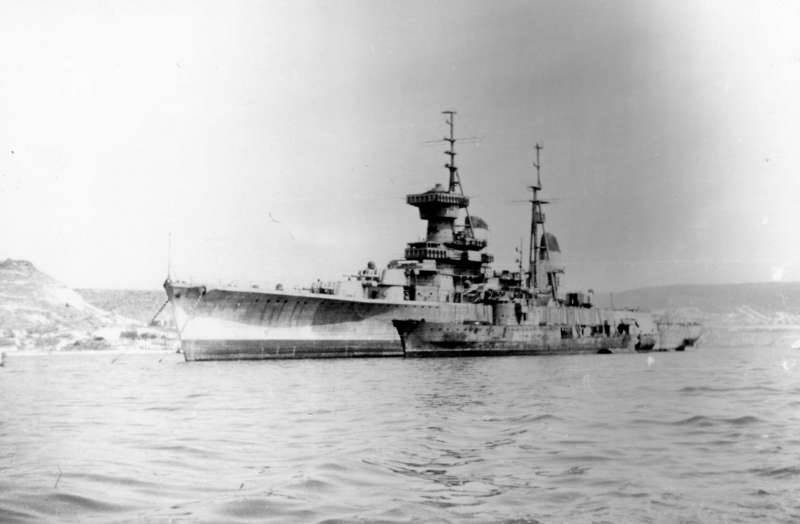
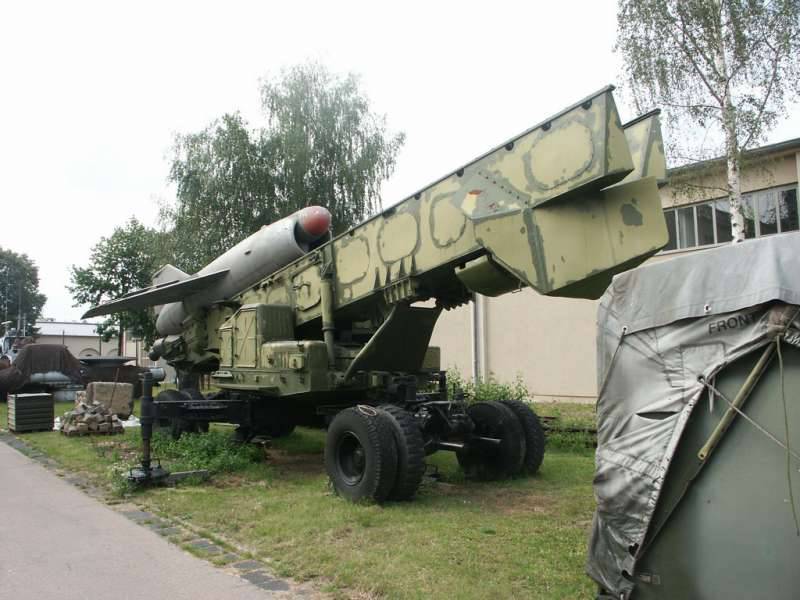
Information